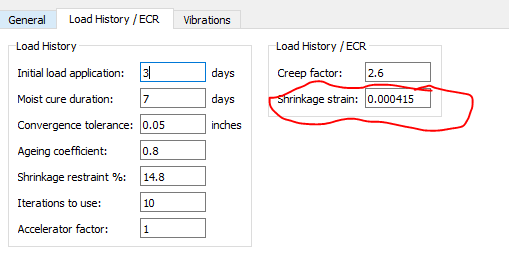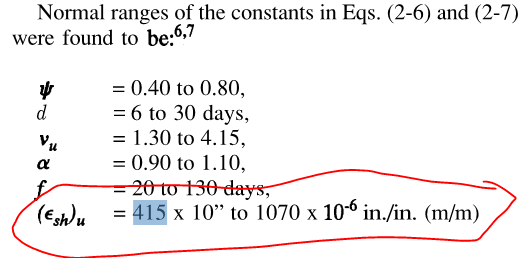sticksandtriangles
Structural
- Apr 7, 2015
- 494
I am trying to get a good estimate for my long term deflections on a concrete podium slab I am designing.
From my brief reading on the topic, long term deflection calcs can be a mixed bag in accuracy (so many variables at play that it is hard to accurately predict).
Anyways, I am noticing that the shrinkage strain input within RAM concept has a big impact on my long term deflection calculations.

I am calculating this shrinkage strain based on ACI 209 (assumes a standard condition of shrinkage strain and apply correction factors) and I have 20in thick slab that has will be curing in a high humidity environment. From my understanding of calculating the adjustment factors per ACI 209, these items (thick slab and high humidity) push my adjusted shrinkage strain very low (0.000237). ACI 209 recommends states "normal ranges from 415X10^-6" to larger numbers.

I am not a long term concrete deflection expert and I want to ensure that utilizing my calculated shrinkage strain is not too low for practical limits. 0.000237 is about 1/2 of the "typical normal ranges" and this low parameter really helps my long term deflection (trying to limit edges of my podium to 0.3" max due to brick being supported above).
Any thoughts on the topic would be appreciated!
Thanks,
S&T
From my brief reading on the topic, long term deflection calcs can be a mixed bag in accuracy (so many variables at play that it is hard to accurately predict).
Anyways, I am noticing that the shrinkage strain input within RAM concept has a big impact on my long term deflection calculations.

I am calculating this shrinkage strain based on ACI 209 (assumes a standard condition of shrinkage strain and apply correction factors) and I have 20in thick slab that has will be curing in a high humidity environment. From my understanding of calculating the adjustment factors per ACI 209, these items (thick slab and high humidity) push my adjusted shrinkage strain very low (0.000237). ACI 209 recommends states "normal ranges from 415X10^-6" to larger numbers.

I am not a long term concrete deflection expert and I want to ensure that utilizing my calculated shrinkage strain is not too low for practical limits. 0.000237 is about 1/2 of the "typical normal ranges" and this low parameter really helps my long term deflection (trying to limit edges of my podium to 0.3" max due to brick being supported above).
Any thoughts on the topic would be appreciated!
Thanks,
S&T

